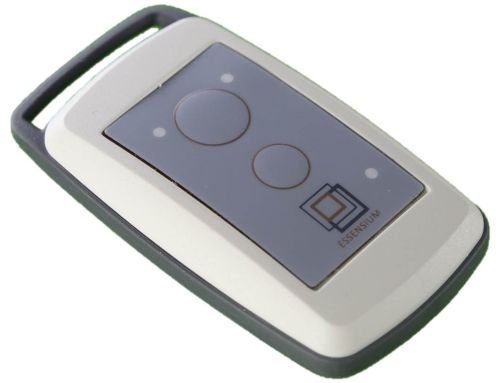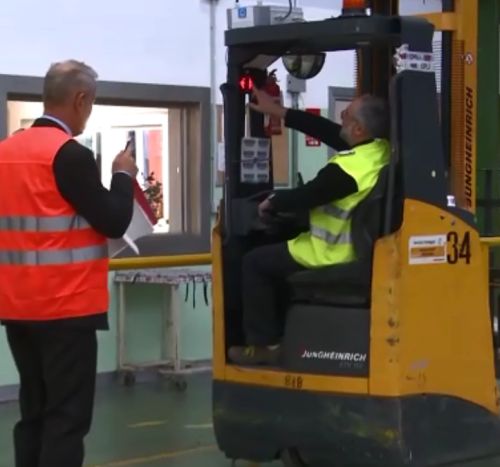Aug 18, 2014One year after cosmetics company L'Oréal Italia installed an RFID-based system to prevent forklift-related collisions in its busy warehouse, the company has not had a single such accident. The solution, provided by systems integrator Deles Matic, is known as the Traffic Collision Assistance System (TCAS) and leverages RTLS technology from Essensium. Essensium provides its SafeTrack collision-avoidance RTLS systems throughout Europe, including at an Antwerp port terminal, to reduce the risk of injuries that result from automated or manned vehicles coming too close to another vehicle or worker. The L'Oréal Italia system consists of Essensium's battery-powered RFID tags, readers and software residing on the company's server, as well as Deles Matic's integrated warning system consisting of stop lights at intersections and warning lights and buzzers on each forklift.
L'Oréal Italia's facility in the city of Lainate has a busy and highly complex warehouse in which employees, on foot or in forklift vehicles, move up and down aisles where products are stored prior to shipment to customers. The company puts considerable emphasis on safety at its facility, and its managers want not only to prevent any accidents but to hear about and learn from any near incidents so that they can be researched and addressed.
The warehouse typically has a high volume of pedestrian as well as forklift traffic on any given day, and on "hot days," when shipping volume is at its greatest, traffic can increase further. The warehouse is designed with two lanes between each row of shelves, one dedicated to pedestrians and another for vehicles. It also has barriers in some areas such as conveyors and "bull bar" fencing that protect pedestrians from forklift traffic. In areas without barriers, or when barriers are not used by pedestrians, collisions could potentially occur if either a pedestrian or forklift operator is not paying attention or visibility is blocked. L'Oréal Italia brought the problem to Deles Matic, which then selected the Essensium solution, says Riccardo Chersoni, Deles Matic's operations director.
L'Oréal Italia had previously looked into an infrared (IR) system to sound alerts when a vehicle entered a specific area, as well as one that used active RFID tags to generate an alarm if a person was too close to a vehicle. However the results of both solutions were disappointing, since there were numerous false alarms (such as warning of a potential collision in the case of pedestrians who were in fact behind a bull fence or in another traffic lane), causing staff to ignore those warnings.
With the TCAS technology, which was installed in August 2013, each staff member wears one of Essensium's proprietary 2.4 GHz RFID tags, fastened via a Velcro strip to the shoulder of a safety vest. In the future, the tag will be integrated into the vest itself.
To enable a longer transmission range, the tag uses a transmission pulse designed to transmit a unique ID similarly to the way data is transmitted over ultra wideband technology, but in this case the unique identifier is sent over a narrow 2.4 GHz band, explains Dirk Devisch, Essensium sales and marketing director. The unique ID numbers on the tags are received by readers, known as SafeTrack Reference Nodes, which then forward that data, via a gateway, to a server where software uses time of flight and signal strength measurements to determine the location within about 30 centimeters, with a read distance up about 250 meters.

A similar tag is attached to each forklift vehicle and powered by the forklift battery (while the personnel badges require their own rechargeable battery). Essensium software identifies the location of the forklift as well as determines when an alert may be necessary, based not only on the location of the tags in its vicinity but also on the perceived speed at which the forklift is traveling based on the transmissions from the vehicle's tag. The alert responses could then be configured according to the rules Deles input to the system.
L'Oréal wanted to be able to alert drivers if there was a pedestrian in their traffic lane, or if they were simply coming too close to another vehicle or a pedestrian when there was no protective barrier.
Each driver also wears a badge with a unique ID number encoded on it. As he climbs onto a vehicle, his prolonged proximity to the non-moving forklift indicates to the system that this specific individual, linked to the ID number of his badge, is operating the vehicle. By determining this, the software does not issue an alert if he is simply near the vehicle, since this pedestrian in fact is the driver of the forklift.
If his moving forklift comes within range of a person or vehicle, the software identifies that event. The software then illuminates the "stop light" installed at the intersection near the forklift, as well as illuminating a light on his vehicle to catch his attention. If he does not respond by slowing or stopping the forklift, the system activates a buzzer installed on the vehicle, to not only catch his attention but that of the pedestrian. The sound gets louder as he gets closer to the pedestrian. If he still does not stop, the forklift power can be shut down as well.

The company not only uses the system to prevent accidents, but collects data every time a near miss occurs, such as where and at what time it happened, and who was driving. In this way the company can better manage its traffic and the training of its operators. Management can also use the software to view the location and movement of staff and vehicles in real time.
Altogether Chersoni says the company has installed 48 readers throughout the warehouse to receive tag transmissions, and provides 50 tags to its workers and 10 tags affixed to forklifts. "A big and valid help is avoiding collisions and accidents," says Chersoni, and adds "I guess this is enough."
For L'Oréal, which was unavailable for comment, the next step will be installation of the system in its other warehouse facilities, although a timeline for such installations hasn't been established.

